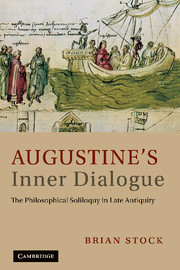4 - Narrative
Published online by Cambridge University Press: 10 January 2011
Summary
Cur ergo tibi tot rerum narrationes digero?
Conf., 11.1.1INTRODUCTION
When he opts for interior dialogue in preference to outer forms of discourse, Augustine makes a choice which has theoretical implications. In this chapter I turn to these considerations under the headings of images, words, time, and memory. His initial statements on these topics take place in the Soliloquia and De Magistro, where he expresses his views on the capacity of images and words to convey certainties, and in book six of De Musica, where he analyses the subjective experience of time. These discussions prepare the way for his reflections on comparable themes in later works, such as books ten and eleven of the Confessions. The result, I propose, is the West's first fully developed narrative philosophy.
I begin my exploration of these themes with a further reflection on the difference between narrative and non-narrative thinking, which has been touched upon in Chapter 3. In Augustine's view, narrative thinking has its basis in a sequence of sounds or images impinging on the senses, which subsequently pass through the sensus interior to the mind, whereas non-narrative thinking arises when the flow of words and images has ceased and the mind is able to determine the significance of what has been said.
- Type
- Chapter
- Information
- Augustine's Inner DialogueThe Philosophical Soliloquy in Late Antiquity, pp. 181 - 228Publisher: Cambridge University PressPrint publication year: 2010

